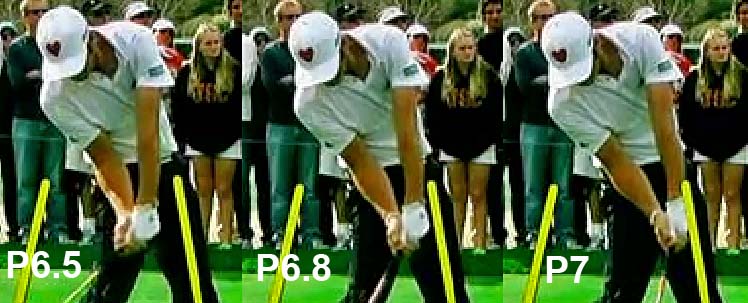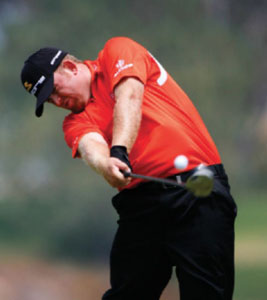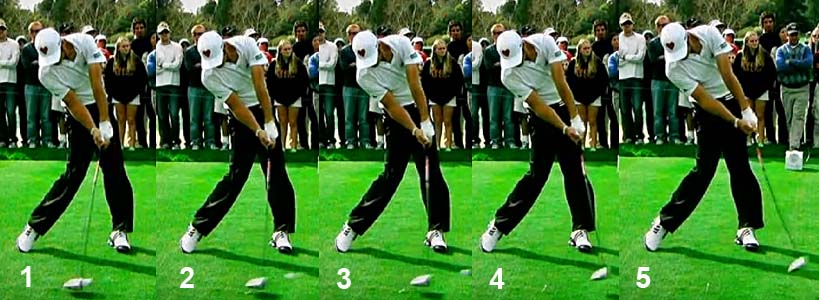Post by imperfectgolfer on Sept 5, 2017 13:34:28 GMT -5
Jim Hardy's wrongheaded interpretation of Dustin Johnson's release action.
In a radio interview with Larry Rinker, Jim Hardy classified Dustin Johnson as a typical RIT golfer because he swings his arms around his body (like a one-plane golfer) and because he seemingly uses a right arm throw motion. However, I think that Jim Hardy is totally wrong to claim that Dustin Johnson is using a RIT release action, and I will provide the reader with many detailed explanatory reasons in order to demonstrate why I believe that Dustin Johnson is not using a RIT release action - based on the fact that Dustin Johnson simply doesn't manifest many of the classical biomechanical elements typically seen in a RIT golfer.
A RIT release action is usually used by golfers who are one-planers and who get their clubshaft down to their original shaft plane (hand plane) by impact and who have a vertical (or near-vertical) left arm at impact with a large accumulator #3 angle. During a RIT release action, Jim Hardy states that a RIT golfer should keep his right elbow close to his right shirt seam, and behind his right hip area, as he rotates his mid-upper torso non-stop through the mid-late downswing and then through impact, which means that he should be using a punch elbow motion (and not a pitch elbow motion). Also, during a RIT release action, Jim Hardy recommends that the RIT golfer should be using a reactive pivot action (and not an active pivot action that is causally responsible for the release of PA#4) and the body should be turning counterclockwise in perfect synchrony with the right arm throw motion, while the right wrist is actively/continuously straightening through impact. During a RIT release action, the hands should also be moving along the path of an inner circle, so that the hands remain very close to the rotating body during the early followthrough action between P7 and P7.5 (which requires the use of a CP-arm release action).
However, Dustin Johnson doesn't manifest any of those classical RIT release elements, which are seen in a prototypical RIT golfer. Dustin Johnson uses an active pivot action to release PA#4 (left arm) and i) his left arm is outstretched at impact with a small accumulator #3 angle. He also uses ii) a pitch elbow motion so that his right palm can be parallel to his intact LAFW during his mid-downswing action. During his late downswing, Dustin Johnson iii) significantly pronates his right forearm (during his PA#3 release action) and that helps him to square his clubface by impact. Dustin Johnson also iv) keeps his right wrist continuously bent through impact, and he doesn't prematurely straighten his right wrist (as seen in a RIT golfer who uses a right arm throw motion, involving an actively straightening right wrist, through the immediate impact zone between P7 and P7.2). Dustin Johnson also uses v) a CF-arm release action between P7 and P7.5, and he does not use a CP-arm release action (which is needed to keep the hands traveling along the inner circle between P7 and P7.5 in a RIT golfer).
Here are multiple capture images from different Dustin Johnson swing videos that will prove all of my five claims.
DTL capture images of Dustin Johnson in the late downswing and at impact.

Image 1 is at P6, image 2 is at P6.5, image 3 is at P6.7 and image 4 is at impact. In the lower images, I have provided close-up images of his left arm/forearm and I have drawn a red line down the center of his left antecubital fossa and a blue line along his left radial bone just above left wrist level - in order to demonstrate how the left forearm continuoulsy rotates counterclockwise between P6 and impact (representing the release of PA#3).
The red line drawn through the clubshaft at impact passes just above his right elbow and exits his back well above the level of his lower thoracic spine. In other words, Dustin Johnson's clubshaft is just above the elbow plane between P6 and impact and he doesn't drop his clubshaft down to the hand plane (original shaft plane) as typically seen in RIT golfers (like Hunter Mahan and Sergio Garcia).
Note how outstretched Dustin Johnson's left arm is at impact and note that his clubshaft is nearly straight-in-line with his left arm, indicating that he has a small accumulator #3 angle at impact. Note that he has a lot of right lateral bend and that his right forearm is near-horizontal between P6 and impact. Dustin Johnson's impact alignment is very characteristic of a golfer who Jim Hardy classifies as being a one-plane hybrid golfer (like Lee Trevino) - being a golfer who uses a "hold-off" type of LOP release action combined with the more horizontal right forearm motion seen in one-plane golfers who swing their arms/clubshaft more around their body, and not up-and-down in front of their rotating body.
Now consider the position and motion of Dustin Johnson's right elbow and right forearm in his late downswing.
Capture images from a face-on video of Dustin Johnson's driver swing.

These three capture images show Dustin Johnson performing his right forearm paddlewheeeling action (biomechanically involving the combination of right arm straightening and right forearm pronation) that allows him to synergistically use his right forearm in order to help him to efficiently release PA#3 in his late downswing (evidenced by the counterclockwise rotation of the glove logo on the back of his left hand between P6.5 and P7). Note that his right forearm is frankly supinated at P6.5 (where his right palm is under the club handle and facing skywards) and that his right forearm is neutral at impact (where his right palm is behind the club handle and facing the target), which means that he is pronating his right forearm a lot between P6.5 and P7 (impact) - and that should theoretically not happen in a RIT release action. Also, note that his right elbow is positioned well in front of his right hip area in a pitch elbow location, and it is not positioned alongside his right shirt seam (and behind his right hip area) as seen in a prototypical RIT golfer who uses a punch elbow motion. Finally, note that he is not continuously rotating his pelvis/mid-torso counterclockwise between P6.5 and impact, while continuously keeping the right elbow positioned behind the right hip area - as Jim Hardy recommends for a RIT golfer.
Now, consider Dustin Johnson's hand release action through impact. Jim Hardy states that a RIT golfer should get the left hand out-of-the-way in the late downswing and early followthrough by first pulling the left hand inwards towards his left thigh while simultaneously allowing the right wrist to continuously straighten and Jim Hardy also states in his book that the left wrist should bend in the followthrough of a RIT release action so that there is no biomechanical impedance to the active right wrist straightening action (which is an integral part of the right arm throw motion seen in a RIT release action). Jim Hardy uses the followthrough swing action of the professional golfer JB Holmes in order to demonstrate these specific biomechanical elements of a RIT release action.
Capture image of JB Holmes' RIT hand release action through impact (image copied unedited from the image in Jim Hardy's book on "The Release").

Note how the clubshaft bypasses JB Holmes' left arm in his early followthrough as he fully straightens his right wrist and simultaneously bends his left wrist (in order to allow the right wrist to fully straighten without creating any left hand impedance to an active right wrist straightening action).
Now, consider Dustin Johnson's "real life" hand release action through impact.

Image 1 is at impact and image 5 is at P7.3.
Note how Dustin Johnson maintains a slightly bowed left wrist all the way through his early followthrough between impact and P7.3 and he never allows his clubshaft to bypass his left arm secondary to a left wrist bending (extension) phenomenon that happens during a RIT release action while the left arm stalls its forward motion through impact. Dustin Johnson, by contrast to a RIT golfer, is using a DH-hand release action where the lead arm/hand doesn't stall its targetwards motion through impact in order to allow the clubshaft to bypass the left arm secondary to an active right wrist straightening action that secondarily bends the left wrist (as seen in JB Holmes' RIT release action). In fact, Dustin Johnson's hand release action can be deemed to be the antithesis of a RIT release action - because the lead arm/hand maintains its forward/targetwards motion so that it perfectly matches the forward angular velocity of the clubshaft and any right wrist straightening phenomenon is very limited in degree so that it never causes the clubshaft to bypass the left arm. Dustin Johnson may be actively straightening his right arm in a right arm throw motion, so that his right palm can apply push-pressure against PP#1 (which is located over the base of the left thumb) through impact and that type of right arm throw action can help to stabilise his left wrist/hand during his DH-hand release action, but it is definitely not the same type of right arm throw action recommended by Jim Hardy for his RIT release action.
Here are upline capture images of Dustin Johnson's DH-hand release action, which demonstrate that he uses a CF-arm release action, and not a CP-arm release action (which is characteristic of a RIT release action), during his followthrough.

Image 1 is at impact and image 5 is at P8. Note how Dustin Johnson uses a CF-arm release action where his left arm and left hand move more targetwards, and only slightly inside-left, during his followthrough action, and they do not move more around his body along an inner circle path (that is very characteristic of the CP-arm release action used in a RIT release action).
In summary, I have described many biomechanical actions/motions used by Dustin Johnson that are not characteristic of Jim Hardy's RIT release action and that are very characteristic of a golfer who is using an active pivot-driven TGM swinging action (lead arm swinging action) that is combined with a CF-arm release action and a DH-hand release action through impact.
Why does Jim Hardy so wrongheadedly mischaracterize Dustin Johnson's arm/hand release action? I believe that the answer is due to two related mental phenomena. First of all, I strongly suspect that Jim Hardy is TGM-illiterate and I suspect that he does not fully understand the biomechanics/mechanics underlying a pivot-driven TGM swinging (lead arm swinging) action. I also suspect that Jim Hardy is profoundly ignorant regarding the differences between a DH hand release action versus a non-DH hand release action (as performed by a golfer who uses a TGM swinging technique). Finally, I think that Jim Hardy is a swing ideologue who only mentally conceives of two major types of release action (a RIT release action and a LOP release action) when he mistakenly tries to categorize every professional golfer as using either one of those two types of release actions (a RIT release action or a LOP release action) - even if the "biomechanical evidence" supporting his "release categorization belief" is very weak.
Jeff.
